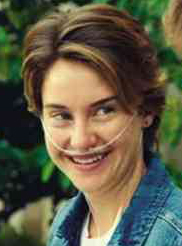Drawbacks, fantasticating turns in romantic drama
“Love story” was a big hit when it was screened many years ago, so it’s no surprise that a younger version thereof, “The Fault In Our Stars,” has been produced for today’s generation of young viewers, and that it’s also doing well at the tills.
This time around, the leads are even younger, just teenagers when they have to cope with terminal illness, and both of them find themselves at death’s door due to different severe cases of cancer.
The new film’s downbeat point of view is that of its 16-year-old leading lady, Hazel, played by Shailene Woodley, while the other lead, Augustus (Ansel Elgort) takes the opposite, more optimistic stance.
At first, Hazel finds absolutely nothing to be happy about, despite her parents’ best efforts to support her, and show that she is oh, so totally loved. She knows she is, but the specter of death that’s constantly looming over her young life is too heavy a burden for her to overcome!
It’s a good thing that Augustus enters her sad life, lifting her spirits like a rainbow after a summer rainstorm, At first, she finds his optimism weird, but he’s such a happy person despite his own affliction that he practically forces her to at least smile.
Article continues after this advertisementFamous author
Article continues after this advertisementThe movie’s plotting takes a rather fantasticating turn when Augustus is able to contact a famous author, Peter van Houten, played by Willem Dafoe, whose novel they both admire to finally answer her e-mails—and to invite both of them to visit him in Amsterdam, to answer their many questions about his mystifying work.
It’s rather incredible that the gruff iconoclast would turn out to be so obliging—but, this is a fictional account, after all.
Another detour that the movie takes is more thematically productive: When the cranky novelist “unwelcomes” them, his apologetic girlfriend takes Hazel and Gus to Anne Frank’s house and “shrine” in Amsterdam.
Like them, Anne was a teen whose life was all too brief—and yet, she never lost hope and the “instinct” to be happy to be alive, despite her severely abridged prospects.
The movie’s young leads are strengthened by her fiercely optimistic example, and it helps them face their own tragedy with courage and great heart. Yes, that does sound a bit too relentlessly upbeat, but it does add to the film’s thematic pertinence and force.
The film is so focused on its desperately ill young leads that it unfairly reduces their similarly brave parents to mere supporting players.
Another drawback is the “cute” but rather improbable plot conceit of Augustus asking his bosom friends to do a “dry run” of his burial service. It’s a “clever” touch, but lugubriously played out, and not really to be believed.
Finally, the film is limited by its young male lead’s excessively “optimistic” projection for much of the movie’s running time. It’s a good thing that he finally breaks down before his imminent demise, otherwise we would think that he’s an incredible male Polyanna up to the bitter end.
It’s a good thing that Shailene is able to come up with a believably vulnerable and felt portrayal. It’s her focused performance that provides the production with the “spine” it needs to come across as an organically unified production.
